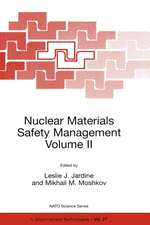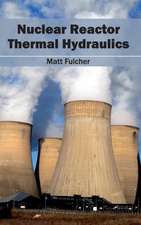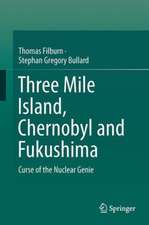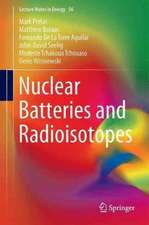Nuclear Materials Safety Management: NATO Science Partnership Subseries: 1, cartea 20
Editat de K. L. Peddicord, Leonard N. Lazarev, Leslie J. Jardineen Limba Engleză Paperback – 14 oct 2012
| Toate formatele și edițiile | Preț | Express |
|---|---|---|
| Paperback (1) | 949.23 lei 6-8 săpt. | |
| SPRINGER NETHERLANDS – 14 oct 2012 | 949.23 lei 6-8 săpt. | |
| Hardback (1) | 955.56 lei 6-8 săpt. | |
| SPRINGER NETHERLANDS – 31 iul 1998 | 955.56 lei 6-8 săpt. |
Din seria NATO Science Partnership Subseries: 1
- 15%
 Preț: 643.65 lei
Preț: 643.65 lei - 18%
 Preț: 949.23 lei
Preț: 949.23 lei - 18%
 Preț: 951.14 lei
Preț: 951.14 lei - 18%
 Preț: 950.96 lei
Preț: 950.96 lei - 18%
 Preț: 1226.42 lei
Preț: 1226.42 lei -
 Preț: 392.97 lei
Preț: 392.97 lei - 18%
 Preț: 944.36 lei
Preț: 944.36 lei - 18%
 Preț: 1227.04 lei
Preț: 1227.04 lei - 18%
 Preț: 1220.26 lei
Preț: 1220.26 lei - 18%
 Preț: 947.35 lei
Preț: 947.35 lei - 18%
 Preț: 952.09 lei
Preț: 952.09 lei - 18%
 Preț: 955.56 lei
Preț: 955.56 lei - 15%
 Preț: 643.65 lei
Preț: 643.65 lei - 18%
 Preț: 947.67 lei
Preț: 947.67 lei - 18%
 Preț: 1111.97 lei
Preț: 1111.97 lei - 18%
 Preț: 1230.66 lei
Preț: 1230.66 lei - 5%
 Preț: 2125.27 lei
Preț: 2125.27 lei - 15%
 Preț: 650.86 lei
Preț: 650.86 lei - 18%
 Preț: 949.23 lei
Preț: 949.23 lei - 15%
 Preț: 640.37 lei
Preț: 640.37 lei - 15%
 Preț: 650.37 lei
Preț: 650.37 lei - 18%
 Preț: 1225.16 lei
Preț: 1225.16 lei -
 Preț: 391.40 lei
Preț: 391.40 lei - 18%
 Preț: 945.14 lei
Preț: 945.14 lei - 5%
 Preț: 1407.87 lei
Preț: 1407.87 lei -
 Preț: 398.15 lei
Preț: 398.15 lei -
 Preț: 390.46 lei
Preț: 390.46 lei
Preț: 949.23 lei
Preț vechi: 1157.60 lei
-18% Nou
Puncte Express: 1424
Preț estimativ în valută:
181.66€ • 188.95$ • 149.97£
181.66€ • 188.95$ • 149.97£
Carte tipărită la comandă
Livrare economică 14-28 aprilie
Preluare comenzi: 021 569.72.76
Specificații
ISBN-13: 9789401061292
ISBN-10: 9401061297
Pagini: 396
Ilustrații: XVI, 378 p.
Dimensiuni: 160 x 240 x 21 mm
Greutate: 0.55 kg
Ediția:Softcover reprint of the original 1st ed. 1998
Editura: SPRINGER NETHERLANDS
Colecția Springer
Seria NATO Science Partnership Subseries: 1
Locul publicării:Dordrecht, Netherlands
ISBN-10: 9401061297
Pagini: 396
Ilustrații: XVI, 378 p.
Dimensiuni: 160 x 240 x 21 mm
Greutate: 0.55 kg
Ediția:Softcover reprint of the original 1st ed. 1998
Editura: SPRINGER NETHERLANDS
Colecția Springer
Seria NATO Science Partnership Subseries: 1
Locul publicării:Dordrecht, Netherlands
Public țintă
ResearchCuprins
Opening the Workshop-Welcome and Introductions.- 1. Remarks of US Representative Mac Thornberry.- Nuclear Materials Safety Management: Framework and Overview.- 2. Relationship of Past US/RF Nuclear Material Safety Management Activities to Workshop Goals.- 3. Toward An Integrated Nuclear Materials Safety Management Approach in the United States and Russia.- 4. Implementing a Nuclear Materials Safety Management Program in the US and Russia.- 5. Nuclear Materials Safety Management: US Perspectives.- 6. Problem of Safe Management of Radioactive Wastes in Russia.- 7 The System of Safety Assurance for Facilities of the Ministry of Atomic Energy of the Russian Federation During Normal Operations and Emergencies.- Overview of Plutonium Storage and Transportation Safety Issues.- 8. Stabilizing Plutonium to Reduce Risk to the Public and Workers.- 9. Long-term Storage of Plutonium.- 10. Technologic Safety Assurance for Plutonium to MOX Conversion.- 11. Principles and Measures for Nuclear Safety in Storage of Excess Weapons-grade Plutonium in the Permanent Storage Facility Being Designed with in the Russian-US Agreement.- 12. Prevention of Accident Consequences in Plutonium Storage.- 13. Experiences in Plutonium Storage and Transportation.- 14. Safety Issues in Plutonium Transport.- 15. Maintenance of Safety During Transportation of Nuclear Materials.- Mox Fabrication and Transportation.- 16. Development of Technology and Equipment for MOX Fuel Production: Provision of Production Safety.- 17. Application of a Plasma-chemical Process for Safe Transformation of Weapons Plutonium into MOX Fuel.- 18 MOX Fabrication and Transportation Safety Issues in Belgium.- Spent Fuel Storage Issues and other Nuclear Materials Safety Topics.- 19. Management of DOE-owned Spent Nuclear Fuel.- 20. US Commercial LWR Spent Fuel Storage.- 21. Safety for Transportation, Reloading, and Storage of VVER-1000 Reactor Spent Fuel at the RT-2 Plant Storage Facility.- 22. Options for MOX Fuel Utilization, Interim Storage, and Disposition in Germany.- 23. Safety Problems in Storage and Transportation of Spent Fuel.- 24. Increasing Technological Safety at the Russian Radiochemical Plant RT-1.- 25. The Problems of Ensuring Safety for Underground Isolation of Nuclear Materials Contained in the Long-lived Radionuclides.- 26. The Application of Geological Similarity Principles for Securing the Safety of Isolation of Plutonium and Other Long-lived Technogenous Radionuclides in Deep Geological Formations and the Development of a Technology for Synthesis of Mineral-like Matrices for Radioactive Waste Immobilization.- 27. Methodology and Results of Studies of Environmental Contamination by Plutonium in Zones of Nuclear Facilities Impact.- 28. The Use of Nondestructive Nuclear Methods to Ensure the Safety of Nuclear Materials Management.- 29. Safety Assessment as a Basis for Decision Making.- 30. Nuclear Safety Arrangements While Storing Enriched Uranium.- 31. Radiation Safety and Work with Plutonium.- 32. Safety of Handling Nuclear Materials at the State Research Center of Russia-Institute of Biophysics.- 33. Container for Transportation and Long-term Storage of Spent Nuclear Fuel.- Meeting of the Nuclear Group of the Amarillo National Resource Center for Plutonium.- 34. Neutronics Benchmarks for the Utilization of Mixed Oxide Fuel in Water Reactors.- 35. Removal and Collection of Gallium from Surplus Weapons Plutonium.- 36. Fuel Test System for Gallium-Zirconium Interaction at the Texas A&M University Nuclear Science Center.- 37. Can-in-Canister Alternative for Vitrification of Surplus Weapons Plutonium: Overview of Thermal Issues.- 38. Evaluation of Thermal Stresses During a Glass Pour.- 39. A Research Program in Automation, Robotics, and Tele-operation.- Strategy for the Nuclear Materials Safety Management Initiative.- 40. Perspectives on Nuclear Materials Safety Management Methods at DOE Sites.- 41. Russian Perspectives on Nuclear Materials Safety Management Methods.- Ongoing Programs.- 42. US-Russian Technical Exchanges on Radioactive Aerosol Monitoring.- 43. Overview of Sandia National Laboratories and Khlopin Radium Institute Collaborative Radiological Accident Consequence Analysis Efforts.- 44. Review of Current Russian-American Joint Projects on Safe Management of Nuclear Materials.- Planning for the Nuclear Materials Safety Management Initiative.- 45. Summary: Planning for the Nuclear Materials Safety Management Initiative.- 46. Protocol of the NATO Advanced Research Workshop on Nuclear Materials Safety Management.- 47. Internet Sites on Nuclear Materials Safety Management, Environmental Safety and Health, Arms Control and Disarmament, Performance-based Management, and Lessons Learned.- Author and Subject Index.



















